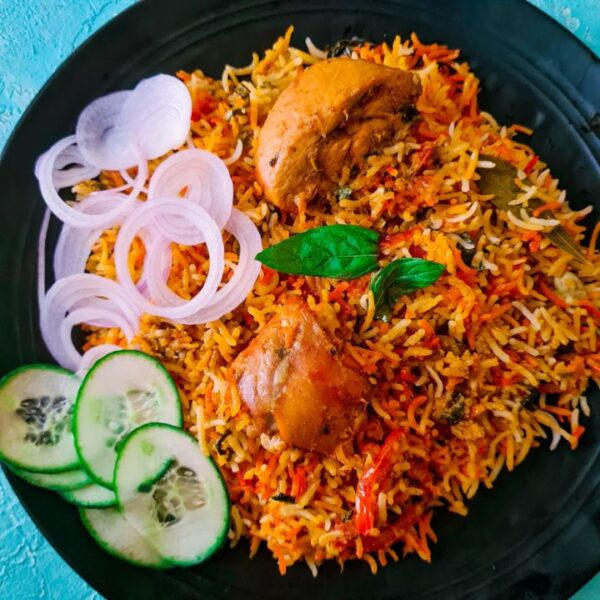TEN RICE DISHES OF THE MOORS

Source:Sailanmuslim
The staple fare of the Moors of Sri Lanka is rice which is consumed with a number of curries or side dishes. The traditional Moorish dishes given below figure on special and festive occasions.
BURIYANI
A favourite rice dish which figures prominently in Moorish feasts is the buriyani, a rich and delectable dish that has its origins in Moghul India. The term itself is of Indian origin and seems to have derived from the Hindustani biryani.
The dish is evidently an old one, for Abul Fazl in his 16th century treatise on Moghul polity, Ain-I-Akbari gives biryan as a meat dish made from sheep with ghee and spices such as saffron, pepper and cuminseed. He also mentions a rice dish known as Duzdbiryan made of rice, meat and ghee. In later times, by the early part of the nineteenth century or before, biryani had come to refer to a specific rice dish. Juffur Shurreef in his Qanoon-e-Islam or the Customs of the Moosulmans of India (1832) refers to Birreeanee as comprising of a dish of boiled rice scattered over fried meat which is then sprinkled over with onions and spices with a little ghee then poured on to it. The term biryan from which biryani derives is a Persian loan in Hindustani literally meaning ‘fried, roasted, broiled, parched, grilled’.
Buriyani is usually made with fragrant bāsmati rice cooked in ghee with meat (usually beef or chicken) and potatoes, spiced with various condiments, scented with rose water and coloured yellow with colouring. It may also be embellished with green peas, cashew nuts and raisins. Accompaniments or side dishes include roasted chicken or chicken curry, an assorted curry made of liver, carrot, peas and cashew nuts, a date and onion pickle known as acchar and a mint sambol made of mint leaves, green chillies, scraped coconut, garlic and ginger, all ground together to form a thick paste known as puduna sambal. Also commonly consumed with the buriyani are slices of pineapple which gives zest and helps in the digestion of this heavy meal. The buriyani served at important functions such as weddings are generally partaken from a sahan or savan, a large metal platter, by a group of six seated around it.
The dish appears to be a relatively recent introduction from the subcontinent. The first to mention it seems to be Elsie Cook in her book A Geography of Ceylon (1931). She says “Their mode of cooking rice, with sultanas and fat, making a dish called burriana, has become characteristic in Ceylon”. In an earlier notice, an advertisement placed by Kamal Pasha Hotel of Maradana in 1923 and published in The Crescent magazine of October1923 we read of ‘buriyani rice’ and ‘fried fowls’ being offered by the hotel, suggesting that the dish would have been introduced from India for commercial purposes and that it was only later that it gained currency as a domestic dish.
KALIVIRUNDU SORU
In the olden days, until about the 1930s or thereabouts, it was not buriyani that was the common festive meal, but rather what was known as Kalivirundu Soru, a rice dish prepared with ghee and various condiments such as cinnamon and embellished with pieces of pineapple, cashewnuts and raisins. Side dishes included potato, mutton curry, kaliya prepared with brinjals and ash plantains, fried beef or chicken and achar (pickle) or a chutney known as bulacchan prepared with tamarind, chillie, sugar, vinegar and onions tempered in ghee.
The term kalivirundu soru used to denote this rice dish appears to derive from the Tamil kali ‘joy, mirth, delight’ and virundu ‘feast, banquet’ which would suggest that the dish was only prepared on very special occasions. The dish is still prepared on certain occasions like weddings, particularly in the rural areas.
NEISORU
Neisoru or ‘ghee rice’ is made by cooking rice in ghee, coconut milk and a variety of spices and condiments such as red onions, garlic, ginger, cinnamon, cardamoms, screwpine leaves (Pandanus latifolia) and curry leaves (Murraya koenigii). Its traditional accompaniment is mashi sambal, a blackish sambol prepared by frying separately in coconut oil red onions, maldive fish, green chillies, pandanus and curry leaves and adding to it powdered chilli, lime juice and salt before mixing it well. Some Eastern Moor folk are also in the habit of pouring over boiled rice freshly heated liquid ghee obtained from the cow (pasu nei) or buffalo (eruma nei). Such rice, taken with red onions and green chillies is said to make a most palatable meal.
KIDU SORU
Yet another well known rice meal is the Kidu or Kiduvu Soru, a rice menu traditionally comprising of cooked samba rice, a curry known as total ( a composite curry made with pumpkin, breadfruit, plantains, sweet potato, red onions and maldive fish), beef curry, mango curry and shredded and cooked jakfruit prepared similarly to the kos maellum of the Sinhalese.
Today however the rice, beef and mango curry which figures in any ordinary kidu is commonly supplemented with potato curry, lentil curry and kaliya (a composite curry made of brinjals and ash plantains) while the total and jakfruit may be omitted. The distinguishing feature of this meal is that it is placed in woven coconut leaf receptacles from which it takes the name of kiduvu. It is commonly consumed during the Ramazan month after the breaking of the fast and often distributed at kandooris held at the shrines of Muslim saints.
KETTU SORU
Kettu Soru is especially prepared by Galle folk and consists of rice, lentils, kaliya, potato curry, karuvadu poricchi (fried dry-salted fish), pilakoṭṭa poricchi (fried jak seeds), batala poricchi (fried sweet potato), eracci poricchi (fried beef), eracci manga (mango chutney), min ticchi (fish cooked to a thick gravy), amuku mutta (boiled and fried egg), pilaka shundal (shredded and cooked jakfruit) and tenga shundal (a yellowish grated coconut and turmeric sambol). This rice meal is packed in a packing made of plantain leaf, hence the name of kettu or ‘packeted’ given to it.
KOPPATTU SORU
The folk of the Eastern areas such as Akkaraipattu and Palamunai once knew of a form of packeted rice known as koppattu soru made from the koppattu or fibrous sheath covering the emerging leaf of the Areca palm (kamuhu maram) though it may still be made on occasion.
The cream-coloured sheet so obtained would serve as a receptacle for rice and a rather dry curry known as shundal by being folded over so that the two ends meet before being rolled from both sides to form a knot at the top. The shundal which accompanies the boiled rice might be leaves such as tirai or ponnangani (Alternanthera sessilis) or pavakka (bitter-gourd) cooked with scraped coconut, red onions and green chilies, or it might even be pieces of kanja eracchi (dried beef) mixed with red onions and green chilies. The leaf is said to have imparted to the rice so packed a most pleasant aroma. It was especially consumed by agricultural workers in the fields and pregnant women to whom it was regularly supplied.
PAL SORU
Pal Soru literally means ‘milk rice’ and is similar to the kiribat of the Sinhalese and pukkai of the Tamils. It is prepared by cooking rice in coconut milk, which when left to cool forms into a cake of firm consistency which is then cut into square- or diamond-shaped pieces. It is usually consumed at feasts given when a girl attains age or the day before the wedding.
The Pal Soru of the Eastern Moors which is likewise prepared by boiling rice in coconut milk has traditionally been of the consistency of a pudding and not so firm as in the case of the Moors of the Western parts of the island. Furthermore, such Pal Soru when prepared for religious functions such as mawloods has traditionally been made of cow’s milk (pasu-paal) instead of coconut milk.
TENGA SORU
The Moors of Jaffna knew of milk-rice which they called Tenga Soru (Coconut rice), a rice meal prepared with a copious quantity of coconut milk. It was consumed at festive occasions such as weddings, mawloods, kattams and other functions along with attarecchi or mutton curry, a composite curry known as kaikari made by cooking together brinjals and ash plantains and a soup known as milahu-tanni prepared with garlic, turmeric, pepper etc. This meal is said to be still prepared by Jaffna Moors domiciled in other areas, though not as frequently.
TANNI SORU
The Moors of the Eastern Province commonly prepare what is known as Tanni Soru (Water rice) which is prepared from the rice left over from the previous night’s cooking. Such rice is mixed with water and left overnight after which it is mixed with red onions and green chillies. Also known as Palan Soru (Old rice), it is often taken in the mornings.
KARACCHA SORU
It happens that the rice found roasted at the bottom of the pot from the previous night’s cooking, known as tinja soru (Burnt rice) is mixed with curd, sugar and bananas or woodapple and taken as a relish during or after meals. In this case it becomes Karacca Soru (Mixed rice) or simply as Karaiyal (the noun form of karacca ‘mixed’).
This rice dish is often taken for breakfast and makes an invigorating meal. It may also happen that on certain occasions such as the pre-dawn meal during the month of Ramadan (sahar) the slightly sour cream white pulp of the Kinnam palam (Sonneratia acida) is added to this rice and curd mixture to give it zest.




















